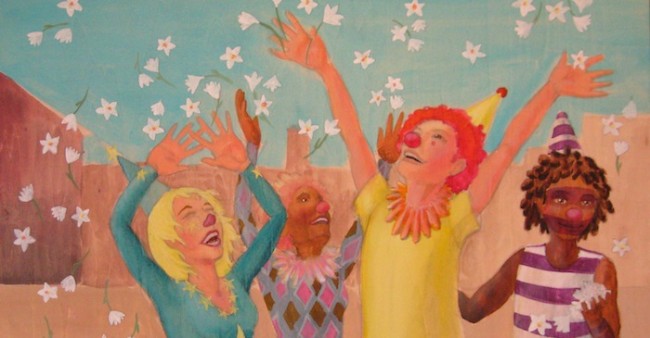 It’s hard to believe that it’s already been a year since my children’s book White Flour came out. A year and two days, actually. Putting out a book or a CD is, in some ways, like having a child. It goes out into the world and has its own adventures, some of which you witness, some you hear about later, and some you never know about. It builds its own relationships and, if it is embraced, it grows past you. That has certainly happened with this book, and it has been a joy to watch (if you haven’t had a chance to read it, you can check it out here).
It’s hard to believe that it’s already been a year since my children’s book White Flour came out. A year and two days, actually. Putting out a book or a CD is, in some ways, like having a child. It goes out into the world and has its own adventures, some of which you witness, some you hear about later, and some you never know about. It builds its own relationships and, if it is embraced, it grows past you. That has certainly happened with this book, and it has been a joy to watch (if you haven’t had a chance to read it, you can check it out here).
Looking back at that year, I’m amazed by the adventures it has had. Patch Adams and Peter Yarrow (of Peter Paul & Mary) have sent kind words of support. I have a photo of Congressman and Civil Rights hero John Lewis holding the book and smiling. Legendary nonviolence theorists like Gene Sharp and Johann Galtung, who are lesser known to the general public but whose work I’ve studied and cited in papers, have written me letters saying how much they like the book. A friend even sent a note to Desmond Tutu about it, and he wrote back enthusiastically.
I began to get an inkling of how this was going to go when the kickstarter campaign blew so far past its original goal. Strangely, that support and excitement hasn’t slowed down much, even a year into the book’s life. That was followed by national media coverage on the Thom Hartmann Show, Atlanta’s CBS Evening news, some wonderful newspaper stories and radio interviews across the country.
By far the most wonderful thing that has happened, though, was on November 10 in Charlotte, NC, when neo-Nazis holding an anti-immigration rally were met by counter-protesters in full clown regalia, chanting ‘white flour!’ and ‘wife power!’ Folks from the Latino Coalition in Charlotte had encountered White Flour and base their real-life protest on it. The rally was in rotation for about 24 hours on CNN, and I heard from people all over the U.S. wondering if I had been involved. The cool part is that I wasn’t. Life was imitating art, which had begun by imitating life.
Since then we’ve added free lesson plans that teachers can download for use in English classes and Sunday School classes, with a Social Studies resource to be added soon. I’ve also been invited into classrooms, both in person and via Skype, to read the book and lead some discussion about the story and about nonviolence in general.
The book made it to the final round of twelve books under consideration for the Jane Addams Book Award, and though it didn’t win in the end, I’m thrilled that it came so close. It has also been adapted and performed by a theatrical poetry troupe in Arkansas and a group of TESOL students who performed it at an international competition in London. In the last couple of months, Southern Poverty Law Center referenced the book and quoted me in an article on the Charlotte rally in their Quarterly Report magazine, and it was featured as a Staff Pick in Teaching Tolerance Magazine.
And what’s next? I keep thinking that the book should slow down soon, but it doesn’t seem to be doing so. I can only guess what adventure awaits.
What I do know is that the stories we tell matter. A good and true story can shift our hearts, open our minds and inspire action. I always smile to myself when I hear people say ‘don’t just talk, do something!’ Talking is doing something, and it very often leads to doing more. Thanks for caring about this book and the story it tells. Here’s to a good story, here’s to the Knoxville clowns who inspired this one, and here’s to those who march on.
David